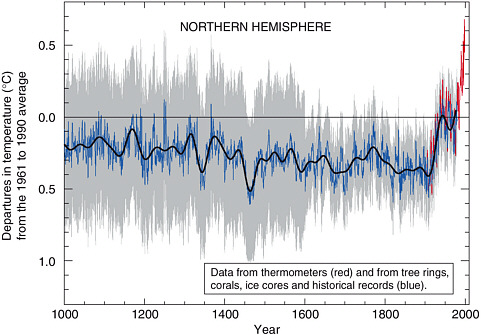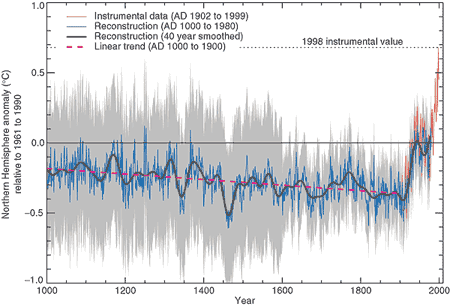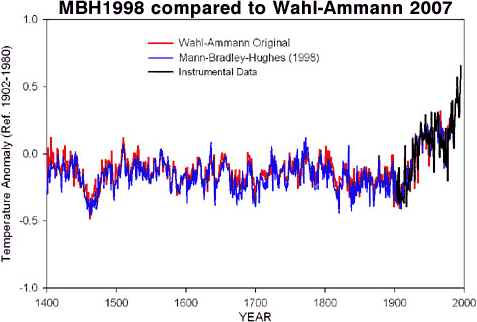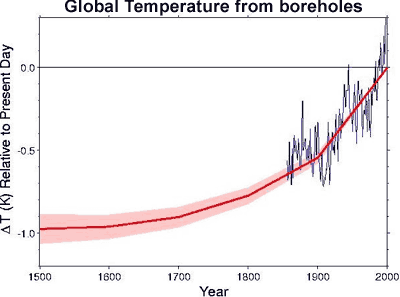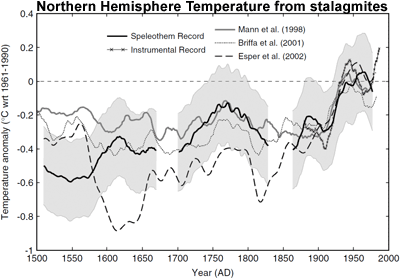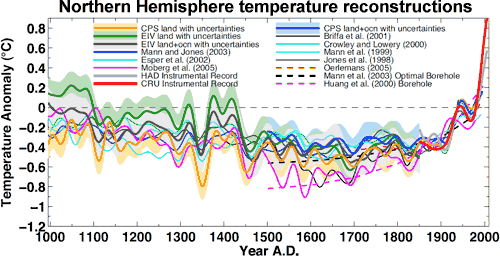The warmist morons don't even notice what the main data Dr. Mann used for his 1998 paper is. It is mentioned in
post 1, but somehow they don't realize that the Bristlecone Pine Tree data is NOT a temperature database at all. Quoting this for as SECOND time.
McKitrick
"A very brief summary of the problems of the hockey stick would go like this. Mann’s algorithm, applied to a large proxy data set, extracted the shape associated with one small and controversial subset of the tree rings records, namely the
bristlecone pine cores from high and arid mountains in the US Southwest. The trees are extremely long-lived, but grow in highly contorted shapes as bark dies back to a single twisted strip. The scientists who published the data (Graybill and Idso 1993) had specifically warned that the ring widths should not be used for temperature reconstruction, and in particular their 20th century portion is unlike the climatic history of the region, and is probably biased by other factors."
Of course there is a GOOD reason that subset was used, namely trees from higher arid mountains are known to more accurately reflect temperature than precipitation. The LAST thing deniers want is accurate data.
New Research on Tree Rings as Indicators of Past Climate
We have shown that approximately 60–80 m of vertical elevation can be sufficient to create a change in the climate response of bristlecone pine.
Trees below this elevation are not as effective temperature recorders as trees at treeline. Such fine-scale sensitivity, if present at other treeline sites around the world, would have important implications for chronology development and inferences of past climate variability.
Treeline site chronologies should be constructed with this vertical heterogeneity in mind. Samples from upper treeline and from trees below treeline should not be mixed to avoid a ‘diluted’ or ‘mixed-signal’ site chronology, particularly at treeline sites that occur in relatively dry environments such as the White Mountains of California. Similarly, treeline samples from differing aspects should not be mixed to avoid problems and uncertainties related to potential ‘divergences’ and to ‘dilution’. Interpretations of existing bristlecone chronologies need to take this into account, particularly when these ring width chronologies are used in climate reconstructions.
I asked Malcolm Hughes and Matt Salzer, two of the study authors, how to best characterize this study. They told me that this paper is, for the most part, “…an ecological study. There are no climate reconstructions, rather mostly comparisons of growth from trees growing in different spots on the landscape.
There are paleoclimate implications. We still find temperature sensitive bristlecone pine trees at upper treeline; they simply don’t extend down the mountain as far as we used to think. In addition, some of the treeline south-facing trees seem to be less influenced by temperature in recent years than they used to be.
The location of the trees, and understanding what environmental variable is limiting growth at that location, is the key to developing accurate paleoclimatic reconstructions from tree rings. Science is a continuous process of improvement.”
Earlier research by an overlapping team also looked at topography. In “Topographically modified tree-ring chronologies as a potential means to improve paleoclimate inference” by Andrew Bunn, Malcolm Huges, and Matthew Salzer (2011) it is noted that
…a mean ring-width chronology from a particular site may be composed of trees from highly varied topographic positions. Such a “topographically-mixed” chronology can be confounded in terms of its climate signal. For example, ring widths of trees that are primarily recording summer temperature might be averaged with ring widths of trees that are primarily precipitation recorders.
That paper details how researchers can use topographic setting to separate different growth series to produce a cleaner sample for developing a temperature proxy. Like the more recent paper discussed here,
Bunn et al is an effort to improve the methodology of using tree rings as a proxy. 


